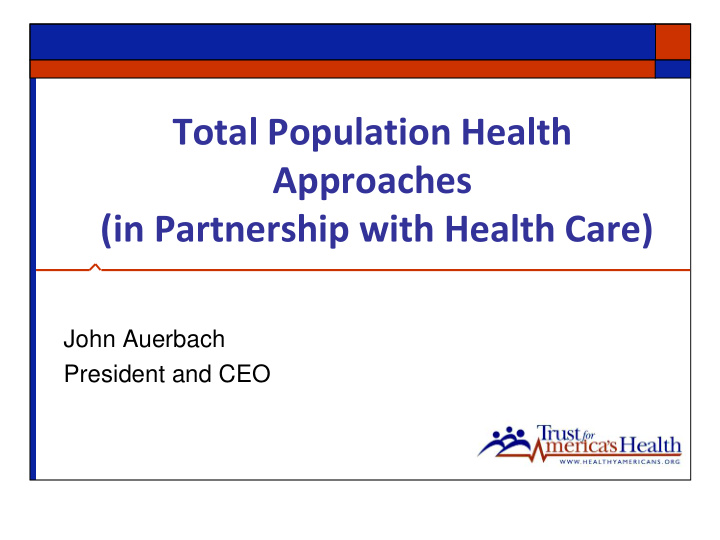



Total Population Health Approaches (in Partnership with Health Care) John Auerbach President and CEO
Meet Fran Edwards: At doctor for first physical in 5 years 55 years old, married, smokes, overweight, little exercise Asthmatic, pre-diabetic Stopped taking medications in past due to cost
She Needs More Than Health Care Income - Low income, family of 5 Barriers to Fitness – Safety, few parks, no nearby supermarket Sub-par Housing – Mold and ventilation problems
Her Doctor Tries to Help Screens for social needs Helps her seek new housing - via local agency Helps meet food needs - on-site help with emergency food assistance
But There's Only So Much Her Doctor Can Do
There Are Many Mrs. Edwards U.S. has shortage of 7.4 M affordable/ available rental homes for poorest 25 % of MD renters spend 50 % or more of income on rent.
Housing Costs: Problem for Both Low & Middle Income People
Same Picture with Food and Other Needs 1 in 6 adults Americans are food insecure; 5 M of them are older adults 24 M live in food deserts 2 M live in low- income, rural areas; 10+ mi. from supermarket
A Total Population Approach Includes: Housing: Expand the housing supply Improve the existing housing stock Lower the cost of housing Food Increase the availability of healthful foods Lower the cost of food Improve mass transit
THE SOCIAL DETERMINANTS SPECTRUM Working in Just One Box is Insufficient Insurers/providers coverage & hospital Government action/funding: public health & benefits other sectors Screening for In-house social Community- Changes to necessary social, services based social & laws, policies, economic and assistance (at related regulations or safety issues in clinical site services ; single community-wide clinical & other where screening conditions; or multiple settings is performed) working across programs or sectors services Addresses patient social needs Addresses community social determinants
How Much Can Health Care Do? The Limits Include: Emphasis on reducing costs of most costly Short term need for return “Attributable” patient focus MD is a model - total respons. for Medicare; all payer pop improvements
Health Care Should Do as Much as Possible Screening Bringing social services in-house Referring skillfully to community agencies Streamlined feedback loops Considering broader needs in its community benefits & investments Supporting resources for other sectors to: Address the community-wide needs Address the underlying problems
The 3 Buckets of Prevention Community-Wide Traditional Clinical Innovative Clinical Prevention Prevention Prevention 3 1 2 Implement Provide services Increase the interventions that that extend care use of clinical reach whole outside the preventive populations clinical setting services Health Care Public Health
Bucket 1: Traditional Clinical Approaches Focus on Preventive Care
Development of 6|18 Initiative Focus on 6 high- cost, high- prevalence conditions Review of CIO evidence-based clinical interventions 18 interventions identified
Make Diabetes Prevention Widely Available
Bucket 2: Innovative Patient-Centered Care Focus on Preventive Care
To Address Asthma : Healthy Home Risk Reduction • Home visit by CHWs to Provide additional education/ encouragement Assess risk factors in the home Assist in removing risk Coordinate/education schools
Bucket 3: Community-Wide Health Focus on Preventive Care
Social Determinants Of Health: More Widely Recognized
cityhealth
Preview of Coming Attractions: Promoting Health Improvement and Cost Controls in States (PHACCS) Trust for America’s Health initiative with support from the Robert Wood Johnson Foundation and Kaiser Permanente The 12 key health policies each state should consider What to expect: The Data on What Works Peer Support and Teaching Technical Assistance To be released in early Feb., 2019
THE SOCIAL DETERMINANTS SPECTRUM Working in Just One Box is Insufficient Insurers/providers coverage & hospital Government action/funding: public health & benefits other sectors Screening for In-house social Community- Changes to necessary social, services based social & laws, policies, economic and assistance (at related regulations or safety issues in clinical site services ; single community-wide clinical & other where screening conditions; or multiple settings is performed) working across programs or sectors services Addresses patient social needs Addresses community social determinants
What’s Your Role? – Improved patient care linked with total population health Policymakers/state agencies: Link payment reform be to wider policy change Legislators, consider: Consider laws/budgets that promote total population health Health care providers: Screen/refer but also support changes that address identified need Community based organizations: Work to change local conditions while linking with health care Foundations, academia, others: Help “plug the holes” along the spectrum
This afternoon Breakout sessions on these topics and areas: Measuring Success in the Maryland Model Engaging Local Communities Behavioral Health Innovations The Role of Primary Care Beyond the Health Care System: Policy, Systems, and Environmental Changes Engaging Consumers Tailoring the Maryland Model for Different Populations As you attend breakout sessions, Help Maryland identify key barriers and opportunities Identify your role Where could state focus and make a difference? What policy and environmental changes are needed?
She Needs Our Help Screening plus in-house social & community services But also policy changes that prevent and address the social determinants
Recommend
More recommend